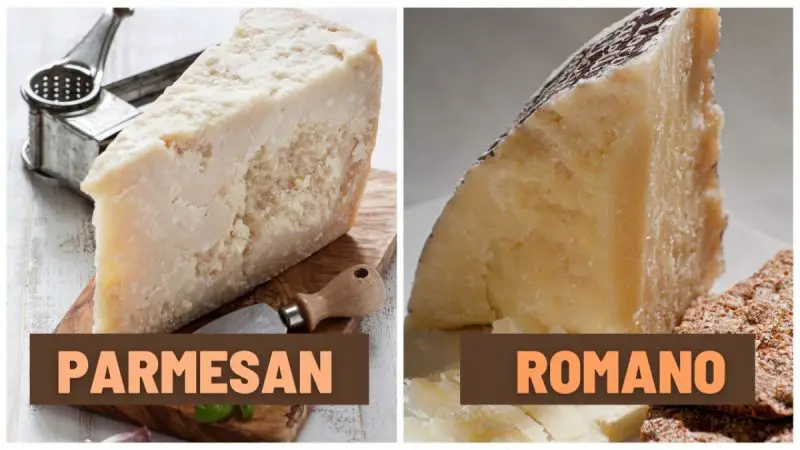Last Updated on January 17, 2024 by Aaron
Romano and parmesan cheese are both popular kinds of cheese that are widely used in dishes around the world. However, there are some key differences between them.
They are classified as grana cheese which means granular and flaky textures — which is suitable for grating. Parmesan is a little milder and sweeter in flavor overall, while Romano cheeses are usually sharper, saltier and also smell pungent.
Romano is a class of cheese that’s commonly referred to as a sharp and salty cheese made from sheep, cow or goat’s milk. The difference in milk source can greatly alter the flavor of each cheese, where some can be grassier or earthier. Pecorino Romano is the most recognized Italian variety made entirely using sheep milk, while Vaccino Romano is made from cow’s milk (therefore much milder in flavor). Romano cheeses have a hard, firm texture with low moisture and are often aged between 5-12 months.
Parmesan cheese, on the other hand, is a longer-aged hard cheese made from cow’s milk. It is usually aged for at least 10 months, or the Parmigiano Reggiano for 12-36 months, where it’ll develop its signature complex floral note. Regular parmesan made in America is typically aged for a shorter period of time (10 months) and tends to be milder than its Italian counterpart. Read the main differences between Parmesan vs. Parmigiano Reggiano. But overall, parmesan cheese tends to be nutty and more buttery compared to Romano. It also has a pleasant aroma and a slightly sweet taste.
Uses: Parmesan is more versatile!
In terms of usage, parmesan can be added to a wide range of dishes for flavor enhancement such as in pizza and pasta or used as table cheese to serve with dessert, while Romano is often used as a topping over pasta, soup or salad dressing due to its strong sharp assertive flavors, though, that are not as easily blended as parmesan.
Both types of cheese are widely used in Italian cuisine and often combined for a divine concoction, although Romano is more commonly found in pasta dishes with highly flavored sauces from the central and southern regions of Italy.
Substituting Romano for Parmesan
If you are in a pinch and need to substitute one for the other, Romano is more strong and can be used as a replacement on many occasions. Alternatively, we’ve discussed a few other good parmesan substitutes here previously that you can use as well.
Depending on the type of Romano used, some may not have the same nutty flavor that parmesan has. Also when substituting, you should also keep in mind that because of its saltiness (of Pecorino Romano), you may want to reduce the amount of salt added to the dish. Ideally, two-thirds of the amount of parmesan needed for the recipe should be used when replacing with Romano.
Overall, both Romano and parmesan are delicious cheeses that can elevate any dish to the next level with their distinctive flavors. Just keep in mind their differences and use the appropriate type for your recipes.

